System Transport Flatbeds are extremely versatile and can carry almost any load type from concrete blocks to mobile homes, machines, lumber or even planes! As a System Transport flatbed truck driver, you will protect your loads with a suitable tarp. System Transport provides all company drivers’ tarps, so System Transport drivers do not need to worry about selecting the correct tarp.
Why tarp? Tarping loads on a flatbed trailer are essential so that the goods you are carrying are protected from nature’s elements; like wind, rain, snow, dust storms, etc… When you drive for System Transport as a flatbedder, getting cargo delivered safely and in perfect shape is a vital part of your job. Maintaining safety – your safety, the safety of your load, and the safety of others on the road around you is also vital for all flatbedders. Every System Transport flatbed driver knows how to tarp well and how to do it safely because tarping can be a dangerous job if done improperly.
In this blog, we discuss what tarping is and why it is important for flatbed truck drivers. We will cover the different types of flatbed loads that require tarping. For Owner Operators we will discuss how to best determine which tarp is right for your load. And finally we will provide tips for tarping safely and correctly as a System Transport Flatbed Driver.
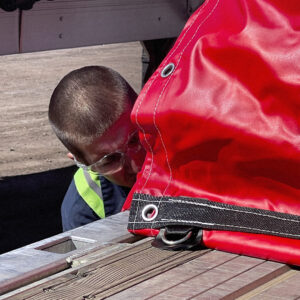
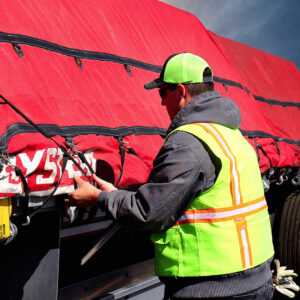
Can tarping a load be dangerous for truck drivers?
When you utilize a tarp, it’s important to remember that these protective devices can pose risks for many reasons. They are large, weighing up to 150 pounds, so they can be difficult to move around. Injuries from improper tarping can include anything from muscle strains to fatal falls, especially in bad weather. Regulations require safe tarping practices, and System Transport offers ways to follow these through rigorous training and orientation guides. System Transport flatbed drivers are expected to follow all laws and safety practices at all times.
- The wind is one of the biggest enemies of truck drivers in the middle of tarping a load. If the process is not done correctly, the tarp can come undone and flap around as the vehicle is moving.
- Another risk comes from climbing onto the trailer to cover a load. Slips and falls from flatbed trailers are common when drivers are not wearing the proper shoes and safety gear, and not following safety guidelines.
What Type of Flatbed Loads Require Tarping?
System Transport provides all company drivers with the appropriate tarp material, so System Transport drivers do not need to worry about selecting the correct tarp. However, if you are an Owner Operator, you will need to select the correct tarp for the load you are hauling.
There are many types of flatbed loads that need tarping. These include steel coiling and tubing, completed machineries like boilers, lumber, vehicle parts, and some construction and industrial equipment. Some loads have mixed cargo, with pieces that need tarping and some that don’t. No matter the situation, it is best to use high-quality tarps so you don’t deliver damaged goods.
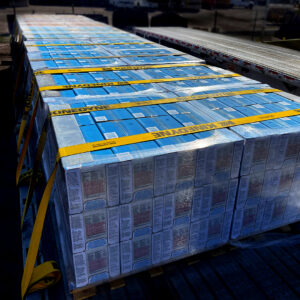
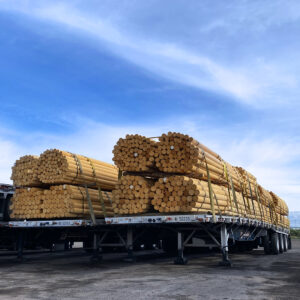
So…Which Tarp Is Right for Your Flatbed Loads?
Your cargo and environmental conditions hold the answer to what tarp is best for your flatbed load. If your cargo has sharp edges, you may need a heavy-duty vinyl tarp. The need for protection from stones, dirt, ice, and water are also important considerations in the decision on the right flatbed tarps for your cargo.
How many types of flatbed tarps are there exactly? Well, quite a few!
- Lumber Tarp – Lumber tarps were created to cover large and bulky loads like timber or hay. They have a flap at the end to fully cover the flatbed load. Usually made from PVC coated polyester, their sides and the tail flap will likely have grommets and D rings to serve as tie-down points to your flatbed trailer.
- Smoke Tarp – Smoke Tarp protects the load from exhaust fumes and dust. This type of tarp covers the front of the flatbed load only. Smoke Tarping is often used together with a steel or lumber tarp for additional cargo coverage.
- Steel Tarp – Steel tarps are most commonly used to protect flatbed loads. They are similar to Lumber tarps but lack the end flaps. Steel tarps also have grommets and D rings. They typically cover lower profile loads.
- Machinery Tarp – Machinery tarps are intended to cover large asymmetrical items such as production and machine equipment. A good machinery tarp should protect the equipment from vibration and inclement weather conditions.
- Coil Tarp – The steel and aluminum industries use coil tarps to cover metal coils. These rounded tarps also protect cable coils, fitting snugly around the coil. Coil tarps have flaps at the base. The corner slits allow for the passage of the transport chain.
- Parachute/Air Bag Tarp – Parachute or airbag tarps (same thing) use different materials on the top and the sides. They are designed to protect the cargo from weather damage. The top is made from waterproof vinyl and the sides are made from water-resistant parachute fabric. Airbag tarps have three rows of D-rings so they are easy to secure.
- Side Kit Tarp – Side kit tarps fit over the top of rigid flatbed side kits. They form the roof of the structure.
- Bee Hauling Tarp – Breathable mesh bee hauling tarps ensure that you can cool and feed bees in transit. Sprinklers or reefers keep the bees cool and the mesh allows water and glucose to drip through. The tarps have reinforced anchors to prevent the bees from escaping through gaps in the tarp. Bee hauling tarps also make a good option for the transport of other live cargo such as plants.
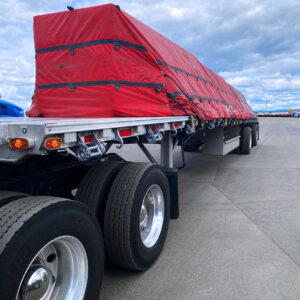
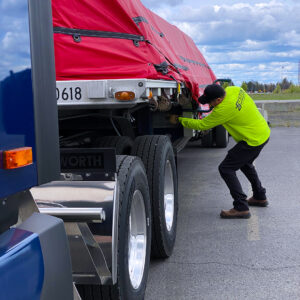
Any other equipment you will need to tarp your System Transport flatbed truck?
You bet! Drivers are also going to need essential equipment pieces to properly tarp their System Transport flatbed loads. These equipment pieces include the following:
- Bungee Cords: Choose from two types of rubber tarp straps.
- Natural Rubber – can withstand freezing temperatures without cracking
- EPDM Rubber – better in warmer weather conditions
- Rubber Ropes: There are (2) two types of rubber rope that can be cut to desired lengths.
- Solid Rubber – used for lightweight cargo
- Hollow Core – for heavier cargo
- Shock Cords: Versatile shock ropes consist of rubber encased in heavy-duty fabric, and they can be cut to length. Choose to add a bungee hook for various cargo types as desired.
Tips for tarping a load correctly
As a System Transport flatbedder, you will now need to consider your location when tarping a load the right way. Avoid wind, rain, and snow by parking in a covered location. If you cannot tarp in a covered area, choose a location where the trees block the wind. When checking a load or retarping on your route, do not stop on the side of the road. This approach is dangerous. Also, you should avoid climbing your trailer if you don’t have a trailer safety ladder.
- Step 1: Place the Tarp on Top of the Load. Use a forklift, step ladder, or platform (whichever is available to you at your terminal), to reach the top of the load. Face the back of the load and place the tarp on top of the loaded flatbed.
- Step 2: Remember – Safety first! Wear non-skid boots to prevent slips and falls. Never walk on a cargo load, but crawl. Use the right tarping equipment, including hooks and tie-downs before beginning tarping.
- Step 3: Begin Tarping. When climbing onto your load, access the flatbed trailer with a safety ladder. This is the best way to keep yourself safe and working efficiently. Unroll the tarp evenly across the load until the cargo is fully covered from side to side.
- Step 4: Secure the Tarp. Once the load is covered secure the tarp to the trailer with rubber tie-downs. Use straps to fold away any loose fabric. If you have a ratchet system on your trailer, use the hooks and secure the straps with the metal bar. If the tarp has a back flap, make sure that there is a solid seal between the trailer and the freight. Fasten the D ring.
Best Part of Tarping?
System Transport offers TARP PAY. That’s right! We pay you more money to tarp correctly and safely. Keep in mind your tarp pay is in addition to your mileage pay. When you drive for System Transport, the #1 Flatbed Carrier in the Western Region, you earn more.
Are you interested in joining the System Transport Flatbed Fleet?
Are you currently working for a carrier that doesn’t recognize and reward your accomplishments? Are you frustrated with your current pay package and lack of career opportunities where you are right now? Join System Transport! We value our drivers and appreciate the essential work you do. If you’re a flatbed truck driver in the western region or west coast with a CDL Class A License, apply for a System Transport truck driving job today! We can’t wait to hear from you. APPLY NOW >

